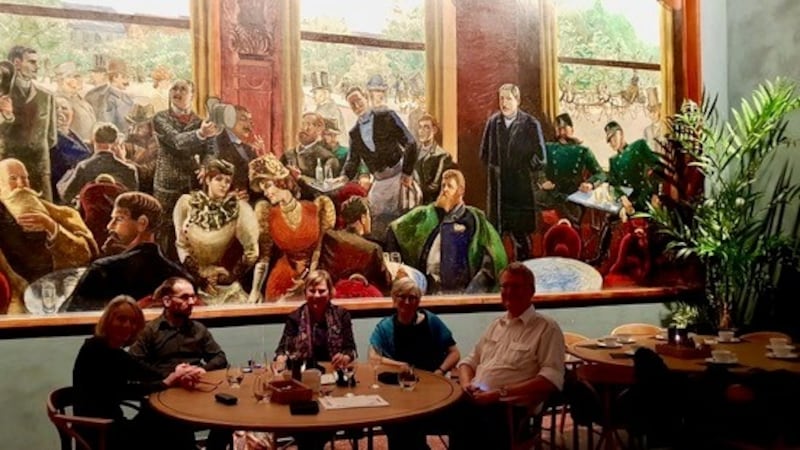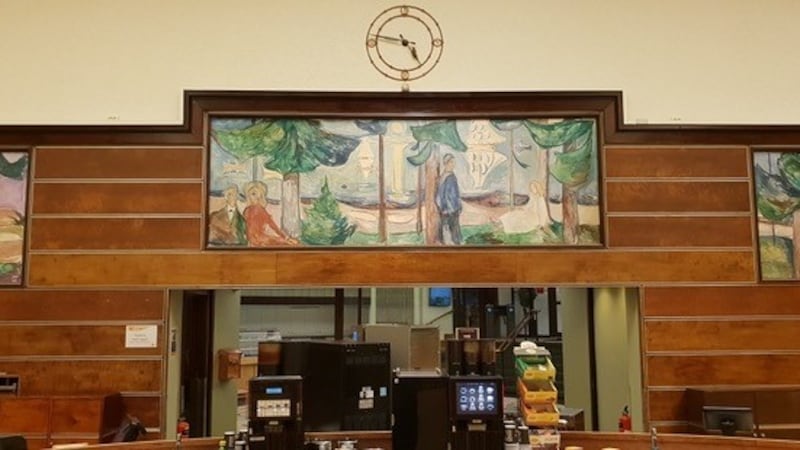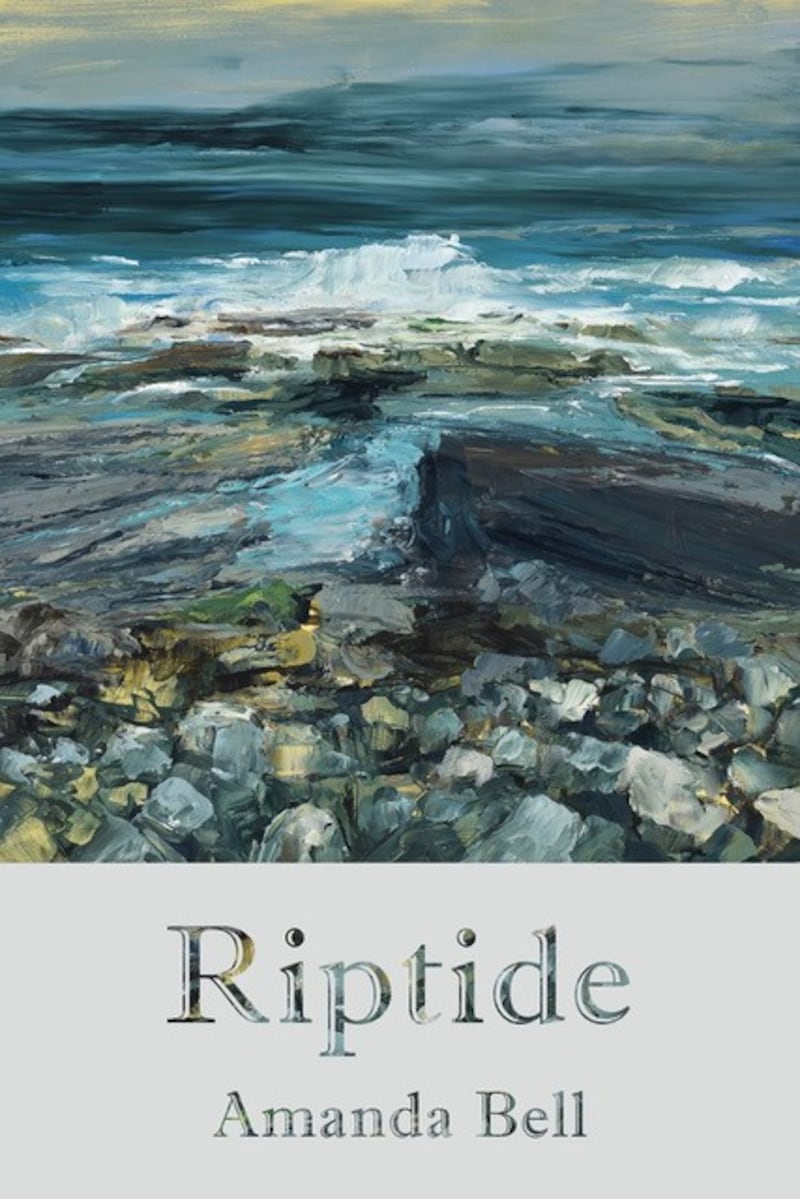I am in my element, either on or in the water. It runs through my work, from the rivers of my debut, Undercurrents, to the turbulent seas of my new collection, Riptide. It is where I do my best thinking, and where things seem to fall into place.
In 2016 I was on a mailboat cruise from Bergen to Kirkenes, researching a novel which features a similar journey. Proofs of a poetry pamphlet were emailed to me as I was about to cross the Arctic Circle, and having them printed out led to a chance conversation with Egbert Pijfers, a Dutchman living and working in Norway, who has an interest in sponsoring projects for artists and writers.
He liked my work, and three years later I was one of three people he invited to participate in The New Scream – an expedition around Oslo to see sites associated with Edvard Munch. We met the artist's great-niece, and visited locations including Freialand chocolate factory – whose workers' canteen is constructed around 12 panels of Munch's work; and the "Munch spot" – the scene at Ekeberg where Munch is alleged to have been inspired by "a scream passing through nature", to create his most iconic work.



On the first night we met for dinner at The Grand Hotel, haunt of the Kristiania Bohème at the turn of the last century. We sat beneath a huge mural by Christian Krohg, depicting 20 or 30 luminaries, including Munch himself. The mural is vast and jewel-coloured, a splendid backdrop to the start of our trip.
Things rarely turn out as expected. For a start, The Scream itself was absent: of the two canvases which should have been on display in Oslo at the time, one was on loan to a museum in Tokyo, and the other had been put into storage preparatory to the National Museum's move to a new premises. Then the trip to Ekeberg, timed for late afternoon in order to view the spectacular sunset over the fjord, was foiled by thick cloud cover. Most confounding, though, was the thing I had forgotten.
On the first morning, as we left the hotel and walked over snowy pavements past the cathedral, Egbert gestured to the courtyard in front of it, remarking: “You should have seen it, covered in flowers, for the dead children.” I had been so preoccupied with visiting this great icon of 20th-century angst that I had completely forgotten about the domestic terrorist attack of 2011. One in four people in Norway had known someone killed in the massacre, and the aftershock still reverberated over the city, almost imperceptible but omnipresent, like the buzz of an electric fence, or the whine of a mosquito. For the rest of the trip it haunted me.
When I returned home from Oslo I began to write, not only ekphrastic responses to Munch’s paintings, but rather trying to explore the feelings that he embodied in his work, and finding parallels in my own life. This is what Munch is renowned for, the ability to convey uncomfortable emotions – grief, anxiety, loneliness, despair – in a pure, distilled form, tapping into the collective unconscious like the most potent poetry.
I travelled to London later that year to see the Love and Angst exhibition in the British Museum. By now I had the core of my new collection, and just as it was beginning to take shape, early in 2020, everything changed. The pandemic and its congruent challenges, from the practical to the existential, proved to be just as destabilising as the events of the early 20th century that were so formative for Munch, who had been traumatised by family deaths and psychiatric illness, as well as stricken with ailments of his own, including a bout of Spanish flu. Caught in the pandemic tidal wave, I was thrown back into my element, with no choice but to be swept along, and the motif of the sea resurfaced in my work.
The most influential landscape for has always been the northwest coast of Co Mayo. I have been visiting the area all my life, humbled by the desolate expanses of blanket bog, and awed by the crashing force of the seas. One of my most vivid dreams as a child was being swept out to sea from the dark stone pavements near Downpatrick Head near Ballycastle, a linear village located along the Wild Atlantic Way.
Since it opened there in 1992, the Ballinglen Arts Foundation has been my favourite exhibition space. It was there that I first came across Donald Teskey's seascapes. The effect was reminiscent of the scene from CS Lewis's The Voyage of the Dawn Treader when the children come across a painting of the sea, are drawn in by the wild, briny smell, then engulfed by the splash of cold waves as they fall through the frame into Narnia. These paintings didn't just represent, but recreated, my experience of that elemental seascape.
Donald Teskey, Ballinglen
These are the seascapes of my dream –
sheer waves, surf a blinding white,
all fractals tilting towards the centre
where a rockpool holds my eye.
I scale down sheets of terraced rock,
then all else fades to nothing
but the tinnitus of surf,
the tiny searchlight
of a yellow periwinkle.
(This poem originally appeared in the online journal The Phare)
If you are caught in a riptide, the best thing is to stay calm and trust that it will bring you back in safely somewhere else. This seems to be true for life and also for poems – let them go and see where they end up. By just such a process of serendipity did my poem end up being included in a unique presentation box of carborundum prints by Donald Teskey published by Stoney Road Press between 2012 and 2014, and gifted by the artist to the Ballinglen Museum this August. I'm both honoured and delighted that Donald Teskey permitted me to use one of his extraordinary, elemental, seascapes – Plaga II – for the cover image of Riptide.



















